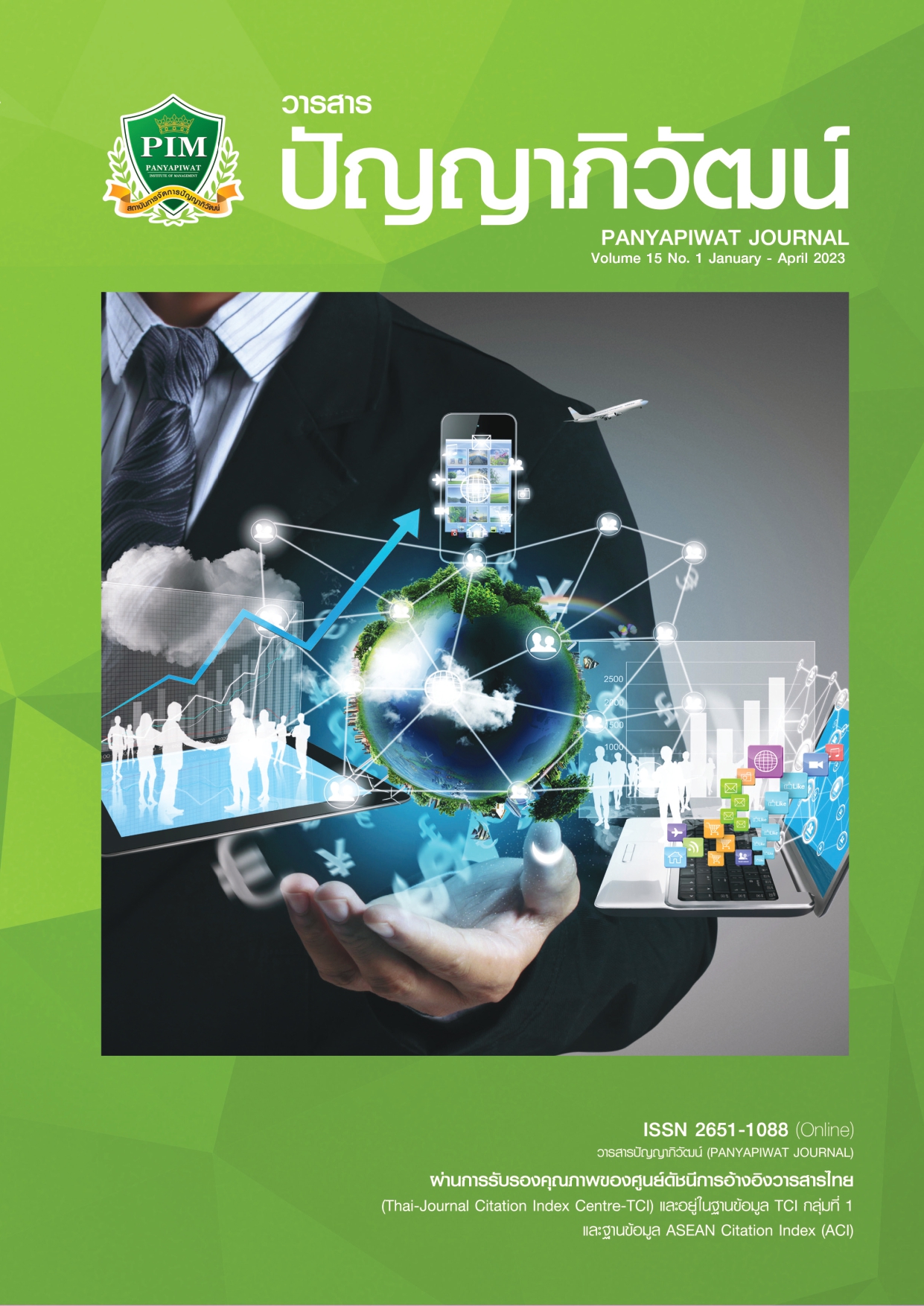อนาคตภาพภาวะผู้นำของผู้บริหารโรงเรียนมัธยมศึกษาไทยในทศวรรษหน้า (พ.ศ. 2563-2573)
Main Article Content
บทคัดย่อ
การวิจัยครั้งนี้มีวัตถุประสงค์เพื่อ 1) ศึกษาอนาคตภาพภาวะผู้นำาของผู้บริหารโรงเรียนมัธยมศึกษาไทยในทศวรรษหน้า และ 2) นำเสนออนาคตภาพภาวะผู้นำของผู้บริหารโรงเรียนมัธยมศึกษาไทยในทศวรรษหน้าด้วยระเบียบวิธีวิจัยแบบ EDFR การวิจัยแบ่งออกเป็น 3 ระยะ ได้แก่ ระยะที่ 1 การศึกษาอนาคตภาพภาวะผู้นำของผู้บริหารโรงเรียนมัธยมศึกษา ระยะที่ 2 เก็บรวบรวมข้อมูล โดยการสัมภาษณ์ผู้เชี่ยวชาญ และนำข้อมูลมาสังเคราะห์ภาวะผู้นำา ระยะที่ 3 เสนออนาคตภาวะผู้นำของผู้บริหารโรงเรียนมัธยมศึกษาไทยในทศวรรษหน้า ประชากรที่ศึกษาคือ ผู้บริหารการศึกษา ผู้บริหารโรงเรียนมัธยมศึกษา จำนวน 21 คน แบ่งเป็น 3 กลุ่ม ได้แก่ กลุ่มผู้บริหารระดับสูง กลุ่มนักวิชาการ และกลุ่มผู้บริหารโรงเรียนมัธยมศึกษา โดยการเลือกแบบเจาะจง เครื่องมือที่ใช้ ได้แก่ 1) แบบสัมภาษณ์กึ่งโครงสร้าง 2) แบบสอบถามความคิดเห็น ชนิดมาตราส่วนประมาณค่า 5 ระดับ สถิติที่ใช้ ได้แก่ ค่ามัธยฐาน ค่าฐานนิยม ข้อมูลเชิงคุณภาพ ใช้การวิเคราะห์เนื้อหา
ผลการวิจัยพบว่า 1) อนาคตภาพภาวะผู้นำาของผู้บริหารโรงเรียนมัธยมศึกษาไทยในทศวรรษหน้ามีคุณลักษณะ 11 ด้าน ได้แก่ (1) ด้านวิสัยทัศน์เพื่อการเปลี่ยนแปลง (2) ด้านความร่วมมือ (3) ด้านการเสริมพลังอำนาจ (4) ด้านการให้และการบริการ (5) ด้านจินตนาการและนวัตกรรม (6) ด้านการเรียนรู้ด้วยกัน (7) ด้านการสร้างชุมชน (8) ด้านการสร้างเครือข่าย (9) ด้านการนำร่วมกัน (10) ด้านการสื่อสารที่เข้มแข็ง และ (11) ด้านการบริหารความก้าวหน้าส่วนบุคคลหรือในวิชาชีพ 2) อนาคตภาพภาวะผู้นำของผู้บริหารโรงเรียนมัธยมศึกษาไทยในทศวรรษหน้า 11 ด้าน ต้องมีองค์ประกอบที่สำคัญคือ 1) มีความรู้ความเข้าใจในองค์ความรู้แต่ละด้าน 2) มีทักษะการใช้ภาวะผู้นำแต่ละด้าน 3) สามารถใช้เทคโนโลยีการสื่อสาร ได้อย่างรู้เท่าทันการเปลี่ยนแปลง
Article Details

อนุญาตภายใต้เงื่อนไข Creative Commons Attribution-NonCommercial-NoDerivatives 4.0 International License.
“ข้าพเจ้าและผู้เขียนร่วม (ถ้ามี) ขอรับรองว่า บทความที่เสนอมานี้ยังไม่เคยได้รับการตีพิมพ์และไม่ได้อยู่ระหว่างกระบวนการพิจารณาลงตีพิมพ์ในวารสารหรือแหล่งเผยแพร่อื่นใด ข้าพเจ้าและผู้เขียนร่วมยอมรับหลักเกณฑ์การพิจารณาต้นฉบับ ทั้งยินยอมให้กองบรรณาธิการมีสิทธิ์พิจารณาและตรวจแก้ต้นฉบับได้ตามที่เห็นสมควร พร้อมนี้ขอมอบลิขสิทธิ์บทความที่ได้รับการตีพิมพ์ให้แก่สถาบันการจัดการปัญญาภิวัฒน์หากมีการฟ้องร้องเรื่องการละเมิดลิขสิทธิ์เกี่ยวกับภาพ กราฟ ข้อความส่วนใดส่วนหนึ่งและ/หรือข้อคิดเห็นที่ปรากฏในบทความข้าพเจ้าและผู้เขียนร่วมยินยอมรับผิดชอบแต่เพียงฝ่ายเดียว”
เอกสารอ้างอิง
Bass, B. M., & Avolio, B. J. (1994). Improving organization effectiveness through transformational leadership. Sage.
Bennis, W. G., & Nanus, B. (1985). Leader: The strategies for taking change. Harper & Row.
Barnes, S. J. (2002). The mobile commerce value chain: Analysis and future developments international. Journal of Information Management, 22, 91-108.
Burns, J. M. (1978). Leadership (15th ed.). Harper & Row.
Center for Creative Leadership. (2015). Essential leadership skills in the 21st century. Colorado Springs.
Criswell, J. W. (2007). Qualitative inquiry and research design: Choosing among five traditions (2nd ed.). Sage.
Daft, R. K. (2005). Organizational theory and design. Thomson South-Western.
Fiedler, F. E. (1967). A theory of leadership effectiveness. Mcgraw-Hill.
Fullan, M. (1998, April 1). Leadership for the 21st century: Breaking the bonds of dependency. ASCD. http://www.ascd.org/el/articles/leadership-for-the-21st-century-breaking-thebonds-of-dependency
George, B. (2010, April 30). The new 21st century leaders. Harvard Business Review. http://blogs.hbr.org/2010/04/the-new-21st-century-leaders-1/
Greenleaf, R. K. (2002). Servant leadership: A journey in to the nature of legitimate power and greatness (25th ed.). Pualist Press.
Hays, J. M., & Kim, C. Y. (2012). Transforming leadership for the 21st century. Xlibris.
House, R. J. (2004). Culture, leadership, and organizations: The Globe study of 62 societies. Sage.
Kaewkong, C. (2007). Opportunity to become a female executive in the context of individual and organizational relationships [Doctoral dissertation]. Thammasat University. [in Thai]
Kanchanakongkha, A. (2012, November 15). Leadership. Human Excellence. http://huexonline.com/uploads/downloads/Leadership_5.pdf [in Thai]
Khamso, S., Sirisuthi, C., & Thammatatsananon, S. (2017). The development of a team empowerment program in schools at the basic education level. Journal of Education Mahasarakham University, 11(1), 170-182. [in Thai]
Lee, D. M. (2008). Essential skills for potential school administrators: A case study of one saskatchewan urban school division [Master’s thesis]. University of Saskatchewan. https://harvest.usask.ca/bitstream/handle/10388/etd-04302008-134115/Essential_Skills_for_Potential_School_Administrators.pdf?sequence=1&isAllowed=y
NASSP. (2013). Breaking ranks: 10 skills for successful school leaders (2nd ed.). NASSP.
Northouse, P. G. (2013). Leadership: Theory and practice (6th ed.). Western Michigan University.
Robbins, S. P., & Coulter, M. (2012). Management (11th ed.). Pearson Education.
Samli, A. C. (2011). From imagination to innovation: New product development for quality of life. Springer-Verlag.
Sandmann, L. R., & Vandenberg, L. (1995). A framework for 21st century leadership. Journal of Extension, 33(6), 1-9.
Sanrattana, W., Phrakrusutheejariyawat, Phrakrudhammapismai, Phramahasuphachai Subha kicco,
Phranatthawut Sabphaso, & Thacha, W. (2018). Leadership for the 21st century. Journal of Education Naresuan University, 20(1), 261-270. [in Thai]
Singmart, S., Meemana, P., & Kaewin, D. (2017). Leadership characteristics of corporate executives in the 21st century. In The 2nd Academic Conference for Presenting Graduate Research Results (pp. 487-493). Mahasarakham Rajabhat University. [in Thai]
Siridhrungsri, P. (2010). Research report on scenario of Thai education in the next 10-20 Years (2nd ed.). Offce of the Education Council. [in Thai]
Somprach, K. (2017). Learning leadership of school principals: A grounded theory study. Social Sciences Research and Academic Journal, 12(34), 51-65. [in Thai]
Stogdill, R. M. (1974). Handbook of leadership: A survey of theory and research. The Free Press.
Strauss, L. (2010). 10 skills critical to owning and outstanding future. Successful Blog. https://www.successful-blog.com/1/10-critical-skills-of-highly-successful-21st-century-leaders/
Tubbs, S. L., & Schulz, E. (2006). Exploring a taxonomy of global leadership competencies and meta-competencies. Journal of American Academy of Business, Cambridge, 8(2), 29-34. https://citeseerx.ist.psu.edu/viewdoc/download?doi=10.1.1.473.9266&rep=rep1&type=pdf


